IMPLEMENTATION OF SEMARANG CITY GOVERNMENT POLICIES IN ACCELERATING STUNTING REDUCTION (A STUDY IN THE WORKING AREA OF BANDARHARJO HEALTH CENTER, NORTH SEMARANG DISTRICT)
DOI:
https://doi.org/10.52152/801856Keywords:
Stunting, health policies, nutritional interventions, cross-sectoral convergence, prevalence reductionAbstract
Health development in Indonesia aligns with the objectives of the SDGs 2030, particularly in reducing stunting as part of achieving the goal of healthy and prosperous living. Stunting is a chronic nutritional issue that poses risks to the physical and mental growth of children, with long-term impacts such as cognitive impairments, low productivity, and an increased risk of chronic diseases. The Semarang City Government has adopted eight convergence actions to strengthen cross-sectoral intervention efforts, including empowering family health posts (posyandu), the Healthy Kitchen to Overcome Stunting (DASHAT) program, utilizing nutrition gardens, and training stunting cadres. Collaboration between government sectors, academia, and the community has been key to significantly reducing the stunting prevalence rate from 1.66% in 2022 to 1.16% in 2023. Despite the decline, challenges remain, particularly in areas such as North Semarang District, which has the highest stunting rates. Socioeconomic factors, limited infrastructure, and the suboptimal implementation of programs, such as stunting daycare and nutritional aid, are major obstacles. Strategic efforts include strengthening research, data, and information for program evaluation and increasing community engagement, particularly among youth, to promote preventive behavioral changes. Local regulations, such as Perwali No. 45 of 2023, provide clear policy directions to integrate various stunting management programs, supporting the achievement of the RPJMN 2020-2024 target of a 14% stunting prevalence rate by 2024.
Downloads
Published
Issue
Section
License
Copyright (c) 2025 Lex localis - Journal of Local Self-Government

This work is licensed under a Creative Commons Attribution-NonCommercial-NoDerivatives 4.0 International License.








